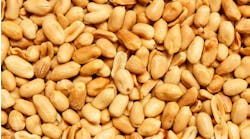While health attributes are emerging as a potent new selling point for nuts in food product development, food formulators and chefs continue to focus on their functionality as an ingredient. Nuts offer recipe developers a range of flavor, texture and appearance advantages, attributes that can subtly transform the ordinary into special treats and upscale fare.
For some things, there is no substitute for nuts.
It's no surprise nuts are emerging as a popular food formulating agent. They are a tasty, easy and often inexpensive solution for enhancing the fat, fiber and calorie profile of food products. While their crunchy texture and rich flavor add value to the eating experience of a wide variety of products, their healthy oil and fiber contents help enhance satiety.
Texture preservation
When consumers see nuts in a foodservice product, they expect a nutty taste and crunchy texture. Those hopes are dashed when the heat lamp or chafing dish turns the gourmet, slivered or sliced nuts in the plated side dish or pilaf into a soggy, pasty mess. Diners and foodservice operators alike are disappointed when the nut toppings on desserts and inclusions in ice cream lose the crisp, snappy consistency associated with toasted nuts in desserts.
When nuts such as almonds, pecans and walnuts are processed, the blanching, slicing and cutting steps open up the cell structure in the nuts. The increased surface makes nuts ideal targets for water migration and the associated decline in texture.
Moisture barrier coatings are one way to minimize this. For savory applications - typical for foodservice - water migration into the particulate can be prevented by coating the pieces with a bland coating that is impervious to water. Nuts such as almonds and pecans may be roasted or coated or toasted with oil to prevent them from absorbing water and getting soggy. Roasting enhances the flavor profile and generates a characteristically stronger flavor, which can become a part of the taste profile of the finished product.
They may look like real nuts, but the coating around this apple is really nut-free Wheat Germ Nuts from Anacon Foods.
For recipes and formulations aimed at individuals with allergies to nuts, there is Wheat Germ Nuts from Anacon Foods Co., Atchison, Kan. The company has unique patented technologies to manufacture an extensive line of flavor particulate products that food processors can use as replacements or cost-effective extenders for natural nut pieces.
Wheat Germ Nuts essentially are nut analogs that can impart the appearance, taste, texture, color and aroma of their natural counterparts to a wide array of processed foods. By duplicating the essential sensory characteristics of nuts in products such as ice cream, cookies and nut pies, they open the range of foods available to those who cannot or should not eat nut-containing foods.
Wheat Germ Nuts contain absolutely no nut derivatives, offer consistent availability, are competitively priced and have a minimum shelf life of 12 months without use of any preservatives.
Kerry Ingredients, St. Louis, offers a line of nut-free particulates that have flavors and textures that closely simulate peanuts and other nuts. Kerry's Custom Food Industries has focused largely on sweet applications and has several particulates formulated to be cost-effective alternates for the more expensive real nuts.
Some nut processors add an aqueous coating solution of water and dextrin. The water is absorbed by the nuts while the dextrin coats the surface of the nuts and serves as a binder to improve the shelf life of the nuts. The dextrin coating also enhances the nut surface for application of dry coatings of powdered flavorings.
Others treat nuts with polyhydric alcohols, including glycerol, and with esters of glycerol as a way to preserve the flavor and moisture content of nuts such as Brazil nuts. One processor coats nuts with a film of pectinate or pectates mixed with glycerol.
Processors are known to apply a molten bonding agent such as glycerol monostearate and other higher fatty acids to the surface of nut meats to solidify the bonding agent.
Heating the nuts in molten sorbitol for a thin coating of sorbitol also has been used to prevent the development of undesirable flavors and odors, especially in broken nuts and pieces. Crispness, hardness and chewability of peanuts can be enhanced by using certain additives such as antioxidants, flavoring compounds and water-soluble organic humectants, including glycerol, sorbitol and propylene glycol.
Peanuts treated this way retain their crunchiness even after extended standing in warm, moist applications, such as Kung Pao Chicken - a spicy stir-fry dish served in some 800 Panda Express restaurants nationwide. The dish is prepared with marinated diced chicken, diced and sliced vegetables and crunchy peanuts, and the peanuts maintain their crunchiness even after an hour in the heated serving trays at the consumer counter.
Favorite nuts
Bruce Kotz, vice president of Golden Peanut Co., Alpharetta, Ga., attributes good positive press on the health benefits of peanuts as a driver for new and creative ways to incorporate peanuts and peanut-derived ingredients into recipes.
Peanuts and nine tree nuts (specifically almonds, Brazil nuts, cashew nuts, hazelnuts, macadamia nuts, pecans, pine nuts, pistachio nuts and walnuts) received a qualified health claim from the FDA in July 2003 linking them with reducing cholesterol and heart disease: "Scientific evidence suggests but does not prove that eating 1.5 ounces per day of most nuts as part of a diet low in saturated fat and cholesterol may reduce the risk of heart disease."
Nearly a year later, walnuts got their own, though greatly watered-down, claim: "Supportive but not conclusive research shows that eating 1.5 ounces per day of walnuts, as part of a low saturated fat and low cholesterol diet and not resulting in increased caloric intake, may reduce the risk of coronary heart disease."
The claims are slowly paying off. "More food companies than ever are now trying to enhance the nutritional profile of their products with the addition of almonds," says Harbinder Mann, technical director of the Almond Board pf California.
Mann reports that more recent clinical research developed subsequent to securing the FDA claim supports the role of almonds as a food that can lower cholesterol. Mann indicated flavonoids and vitamin E are thought to be responsible for the cholesterol-lowering abilities. Research at Tufts University suggests synergism from the flavonoids found primarily in almond skins with vitamin E in the almond meat in preventing LDL cholesterol from being oxidized. Oxidization apparently makes "bad" cholesterol stickier and more likely to clog arteries.
Extended contact with moist ingredients and freezing can soften the texture of nuts, so care must be taken in formulating for these conditions.
Not surprisingly, the almond industry is doing its part to raise awareness of the importance of flavonoids in almond skins and promote their application in foods. Almond bran powder is expected soon as a new offering for enhancing the fiber content, nutritional profile and flavor of foodservice fare.
Already armed with two health claims, walnut producers received a boost when fast food icon McDonald's created the Fruit and Walnut Salad. McDonald's version of the popular Waldorf salad includes a side of low-fat vanilla yogurt instead of mayonnaise and relies on the protein, fat and fiber content of walnuts and the fiber in apples to create the feeling of satiety.
In the process, McDonald's is mainstreaming omega-3s in restaurant foods with its selection of walnuts - which have the highest concentration of the fatty acids of all nuts. Omega-3s are unsaturated and also very susceptible to spoilage. To protect this ingredient from spoilage, McDonald's selected candied walnuts from for Diamond Foods Inc., Stockton, Calif. The candy coating adds sweetness to soften the sometimes sharper taste of walnuts and, most importantly, acts as a barrier to oxidation and spoilage.
Walnuts are showing up in the baked goods produced by quick-service restaurants with artisan bread selections. Companies such as fast-growing Panera Bread, St. Louis, and the Chicago-based Corner Bakery chain are adding walnuts to their fare. Dick Wolf, vice president of ingredients and foodservice at Diamond, also foresees walnut-based pesto and other sauces, walnut veggie burgers and nut coatings for frozen fish.
Dealing with rancidity
|
Overall, it is best to follow the "first in, first out" rule with nuts. Here are a number of considerations for their storage:
|
Rancidity is a major issue with nuts. Tate & Lyle, Decatur, Ill., developed a panning coating process, used much like candy or confection panning, which can adhere flavors to soy nuts, hazelnuts and peanuts. The nuts are tumbled with a bland syrup for better adherence of the flavors or spice mix added next. It also gives the nuts a crisp cracker-like coating.
"The coating may be baked or fried for further color and taste development without changing the integrity of the coated nuts," says Doris Dougherty, senior food scientist at Tate & Lyle. These ingredients are finding their way into upscale restaurants where chefs are increasingly applying a nut-based crust to rapidly brown and add flavor and texture to a fish fillet, a slice of foie gras or a piece of meat.
Chefs have figured out the nutty crust also helps to seal in the juices and introduce a crunchy texture without overcooking the interior. Mark Dorian, chef at Di Pescara, a Lettuce Entertain You restaurant in Northbrook, Ill., uses almonds seasoned with herbs to coat whitefish fillets.
Shelled pecans have healthfully high quantities of unsaturated fatty acids, which, however, tend to undergo degradation resulting in rancid off-flavor. Storage at low or freezing temperatures is one way to slow spoilage but is costly.
Researchers at USDA have developed edible coatings to extend the shelf life - and prevent rancidity - of pecans at room temperature. The researchers found coating pecans with hydroxypropyl cellulose (HPC) and carboxy methylcellulose (CMC) plus various other additives restricted oxygen contact with the nut fats and prevented spoilage without affecting the texture of the nut pieces.
Low-calorie options
Fisher Nuts has promoted nuts in nontraditional food usage occasions, including as a crunchy protein source in salads.
All the positive health attributes aside, nuts still have a problem with fats. In regular nuts, fat may represent as much as 50 to 70 percent of the total weight and provide an even greater proportion of the total calories.
Defatted nuts are one solution. However, they often are not as flavorful and lack the mouthfeel and textural attributes of their original, higher fat versions. This is because the process of removing fat also removes flavor compounds and often changes the texture of the material for the worse.
There are a number of methods for producing partially defatted nuts today. So formulators should inquire about the defatting method to ensure they are getting the appropriate functionality in their ingredient of choice.
Some "partially defatted peanuts" or "low-calorie peanuts," for example, are produced by pressing the raw or blanched nuts until a portion of their oil is removed. They then are steamed or cooked in water or in water containing a flavoring agent to reconstitute the pressed nuts substantially back to their original size and shape. These reconstituted nuts may then be further processed - for example, they may be heated in oil, dry roasted, etc. Often, flavoring is added to the oil or water bath step; the flavoring sometimes is of a different nut type to provide a synergistic richness in taste.
Cost notwithstanding, nuts offer food processors a valuable ability to differentiate products using subtle enhancements. In addition to conveying value and cache, nuts also offer a unique food-based rather than a nutrient-based approach for enhancing foodservice fare.


